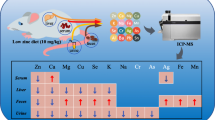Abstract
Two groups of 16 rats each were fed the same diet with 12.9 ppm Zn. Nine days after each animal was injected with65Zn for assessing fecal zinc of endogenous origin, zinc intake and excretion were determined for a six-day period at the age of about five (group I) and nine (II) weeks. At mean growth rates of 5.1 and 5.2 g/day, food consumption per gram of gain was 2.01 g in group I vs 2.86 g in II. Overall, zinc retention amounted to 21 vs 25 μg Zn/g of gain. Apparent absorption averaged 92 vs 74% of Zn intake (132 vs 189 μg/day), while true absorption averaged 98 vs 92%. It was concluded that endogenous fecal zinc excretion was limited to the indispensable loss (F em) in group I (7 μg/day), while it exceeded this minimum loss in group II (33 μg/day). True retention, which reflected total zinc utilization (true absorption times metabolic efficiency), was derived from apparent absorption plusF em (11 μg/day for group II according to the greater metabolic body size of the rats). It averaged 98% of Zn intake in group I vs 80% in group II. The mean metabolic efficiency was 100% vs 87%. The conclusion was that these marked differences between age groups in utilizing the dietary zinc reflected the efficient homeostatic adjustments in absorption and endogenous excretion of zinc to the respective zinc supply status.
Similar content being viewed by others
References
F. A. Suso, and H. M. Edwards,Poultry Sci. 47, 991 (1968).
W. H. Strain, W. J. Pories, E. Michael. R. M. Peer, and S. A. Zaresky, inTrace Element Metabolism in Man and Animals, vol. 3, M. Kirchgessner, ed., Arbeitskreis Tierernährungsforschung Weihenstephan, 1978, pp. 132–135.
H. E. Erdman, D. D. Mahlum, and M. R. Sikov,Int. J. Biochem. 2, 589 (1971).
A. H. Methfessel, and H. Spencer,Rad. Res. 43, 237 (1970).
R. M. Forbes, and M. Yohe,J. Nutr. 70, 53 (1960).
J. Pallauf, and M. Kirchgessner,Z. Tierphysiol., Tierernährg. Futtermittelkde.30, 193 (1972).
H.-J. Lantzsch, H. Schenkel, and K. H. Menke,Z. Tierphysiol., Tierernährg. Futtermittelkde.38, 106 (1977).
E. Weigand, and M. Kirchgessner,Nutr. Metabol. 22, 101 (1978).
M. Kirchgessner, and W. A. Schwarz,Arch. Tierernährg. 26, 3 (1976).
E. Weigand, and M. Kirchgessner,Z. Tierphysiol., Tierernährg. Futtermittelkdae.39, 325 (1977).
E. Weigand and M. Kirchgessner, inTrace Element Metabolism in Man and Animals, vol. 3, M. Kirchgessner, ed., Arbeitskreis Tierernährungsforschung Weihenstephan, 1978, pp. 106–109.
J. Pallauf, and M. Kirchgessner,Arch. Tierernährg. 26, 457 (1976).
E. Weigand, and M. Kirchgessner,Nutr. Metabol. 20, 307 (1976).
E. Weigand, and M. Kirchgessner,Nutr. Metabol. 20, 314 (1976).
E. Weigand, and M. Kirchgessner,Z. Tierphysiol., Tierernährg. Futtermittelkde. 42, 44 (1979).
M. Kirchgessner, and W. Oelschläger,Arch. Tierernährg. 11, 310 (1961).
W. A. Schwarz, and M. Kirchgessner,Arch. Tierernährg. 25, 597 (1975).
M. Kirchgessner, H. L. Müller, E. Weigand, E. Grassmann, F. J. Schwarz, J. Pallauf, and H.-P. Roth,Z. Tierphysiol. Tierernährg. Futtermittelkde. 34, 3 (1974).
R. G. D. Steel, and J. H. Torrie,Principles and Procedures of Statistics, McGraw Hill, New York, 1960.
E. Weigand, and M. Kirchgessner,Z. Tierphysiol. Tierernährg. Futtermittelkde. 39, 16 (1977).
M. Kleiber, A. H. Smith, and T. N. Chernikoff,Am. J. Physiol. 156, 9 (1965).
J. K. Miller, and R. G. Cragle,J. Dairy Sci. 48, 370 (1965).
W. J. Miller, Y. G. Martin, R. P. Centry, and D. M. Blackmon,J. Nutr. 94, 391 (1968).
E. Weigand, and M. Kirchgessner,Z. Tierphysiol. Tierernährg. Futtermittelkde. 39, 84 (1977).
M. Kirchgessner, and J. Pallauf,Z. Tierphysiol., Tierernährg. Futtermittelkde. 29, 77 (1972).
J. Pallauf, and M. Kirchgessner,Zbl. Vet. Med. A 19, 594 (1972).
P. J. Wilkins, P. C. Grey, and I. E. Dreosti,Brit. J. Nutr. 27, 113 (1972).
H.-P. Roth, and M. Kirchgessner,Res. Exp. Med. (Berl.) 174, 283 (1979).
B. Momčilović, B. Belonje, A. Giroux, and B. G. Shah,Nutr. Rep. Int. 12, 197 (1975).
E. J. Underwood,Trace Elements in Human and Animal Nutrition, 4th ed., Academic Press, New York, 1977, p. 209.
Author information
Authors and Affiliations
Rights and permissions
About this article
Cite this article
Weigand, E., Kirchgessner, M. Change in apparent and true absorption and retention of dietary zinc with age in rats. Biol Trace Elem Res 1, 347–358 (1979). https://doi.org/10.1007/BF02778836
Received:
Accepted:
Issue Date:
DOI: https://doi.org/10.1007/BF02778836




